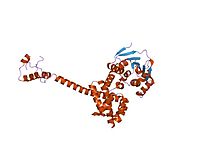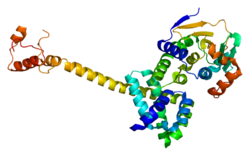| Cdc37 N terminal kinase binding | |||||||||
|---|---|---|---|---|---|---|---|---|---|
| Identifiers | |||||||||
| Symbol | CDC37_N | ||||||||
| Pfam | PF03234 | ||||||||
| InterPro | IPR013855 | ||||||||
| SCOP2 | 1us7 / SCOPe / SUPFAM | ||||||||
| |||||||||
| Cdc37 Hsp90 binding domain | |||||||||
|---|---|---|---|---|---|---|---|---|---|
 complex of hsp90 and p50 | |||||||||
| Identifiers | |||||||||
| Symbol | CDC37_M | ||||||||
| Pfam | PF08565 | ||||||||
| InterPro | IPR013874 | ||||||||
| SCOP2 | 1us7 / SCOPe / SUPFAM | ||||||||
| |||||||||
| Cdc37 C terminal domain | |||||||||
|---|---|---|---|---|---|---|---|---|---|
 complex of hsp90 and p50 | |||||||||
| Identifiers | |||||||||
| Symbol | CDC37_C | ||||||||
| Pfam | PF08564 | ||||||||
| InterPro | IPR013873 | ||||||||
| SCOP2 | 1us7 / SCOPe / SUPFAM | ||||||||
| |||||||||
Hsp90 co-chaperone Cdc37 is a protein that in humans is encoded by the CDC37 gene.[5] This protein is highly similar to Cdc 37, a cell division cycle control protein of Saccharomyces cerevisiae. This protein is a HSP90 Co-chaperone[6] with specific function in cell signal transduction. It has been shown to form complex with Hsp90 and a variety of protein kinases including CDK4, CDK6, SRC, RAF1, MOK, as well as eIF-2 alpha kinases. It is thought to play a critical role in directing Hsp90 to its target kinases.[7]
- ^ a b c GRCh38: Ensembl release 89: ENSG00000105401 – Ensembl, May 2017
- ^ a b c GRCm38: Ensembl release 89: ENSMUSG00000019471 – Ensembl, May 2017
- ^ "Human PubMed Reference:". National Center for Biotechnology Information, U.S. National Library of Medicine.
- ^ "Mouse PubMed Reference:". National Center for Biotechnology Information, U.S. National Library of Medicine.
- ^ Dai K, Kobayashi R, Beach D (September 1996). "Physical interaction of mammalian CDC37 with CDK4". The Journal of Biological Chemistry. 271 (36): 22030–22034. doi:10.1074/jbc.271.36.22030. PMID 8703009.
- ^ Mollapour M, Neckers L (March 2012). "Post-translational modifications of Hsp90 and their contributions to chaperone regulation". Biochimica et Biophysica Acta (BBA) - Molecular Cell Research. 1823 (3): 648–655. doi:10.1016/j.bbamcr.2011.07.018. PMC 3226900. PMID 21856339.
- ^ "Entrez Gene: CDC37 cell division cycle 37 homolog (S. cerevisiae)".





